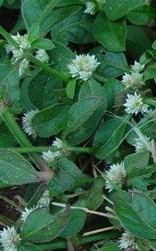 This perennial weed is a member of the amaranth family (Ameraceae) that includes spinach, celosia, and alligator weed. It appears to be native to tropical and tropical regions of the Old World but may have originated in Central and South America. Also known as dwarf copperleaf, it thrives in moist areas with high humidity and may be found near ponds, canals, reservoirs, along streams and rivers, and in flood plains, swamps and shallow ditches. It is drought tolerant, however, and grows in such areas as wasteland, fields, and gardens.
This perennial weed is a member of the amaranth family (Ameraceae) that includes spinach, celosia, and alligator weed. It appears to be native to tropical and tropical regions of the Old World but may have originated in Central and South America. Also known as dwarf copperleaf, it thrives in moist areas with high humidity and may be found near ponds, canals, reservoirs, along streams and rivers, and in flood plains, swamps and shallow ditches. It is drought tolerant, however, and grows in such areas as wasteland, fields, and gardens.
Description
Prostrate stems grow four to forty inches long from strong taproots and often root at the nodes. The leaves are elliptic to lanceolate and from ½” to six inches long. The tiny white flowers appear in the summer in dense stalkless spikes and give rise to small fruits each bearing a single seed that may be dispersed by wind or water.
Control
There is little information concerning control of this weed in the US. Plants can be dug out of the ground bbeing sure to get the tap root. In addition, remove flowers as soon as they appear so the plant does not set seed. Studies outside the US indicate that measures taken to control closely related alligator weed might be successful. These include the release of alligator weed flea beetle, alligator weed thrips, and alligator weed stem borer as well as several chemicals but these methods are not readily available to the homeowner. Broad spectrum herbicides like Roundup can be used in severe infestations. Check with your country agent for up to date control measures that will be most effective in your area without damaging the environment.